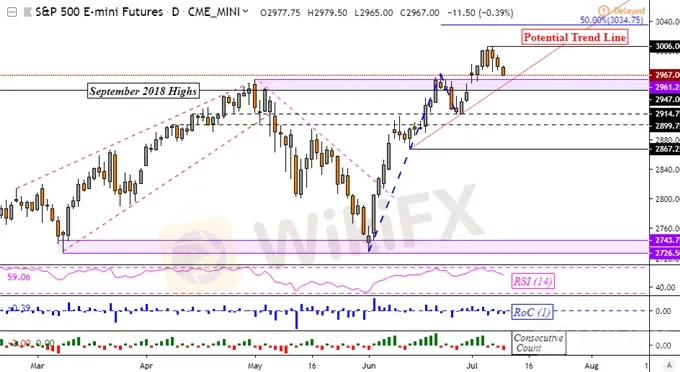简体中文
繁體中文
English
Pусский
日本語
ภาษาไทย
Tiếng Việt
Bahasa Indonesia
Español
हिन्दी
Filippiiniläinen
Français
Deutsch
Português
Türkçe
한국어
العربية
Markets Risk Averse, S&P 500 Net-Short Bets Put Support In Focus
Abstract:Equities are showing signs of risk aversion ahead of testimony from Fed Chair Jerome Powell, though S&P 500 net-short positioning may precede a turn higher as support looms.
Asia Pacific Markets Talking Points
Stocks trade lower in Asia after disappointing US session
Markets seem to be nervous ahead of the Powell testimony
S&P 500 fall facing roadblock, net-short positioning rises
Find out what retail traders equities buy and sell decisions say about the coming price trend!
Stocks traded mostly lower in Tuesday Asia Pacific trade, echoing the nervous behavior from the prior Wall Street trading session. Absent a major catalyst in a relatively quiet session, markets seemed to be anxiously awaiting this weeks testimony from Fed Chair Jerome Powell and the latest FOMC meeting minutes.
China‘s Shanghai Composite, Australia’s ASX 200 and South Korea‘s benchmark KOSPI declined about 0.6, 0.3 and 0.2 percent to the downside. Meanwhile, Japan’s Nikkei 225 was little changed. There, underperformance in information technology was balanced by a pickup in communication services.
A cautious decline in front-end US government bond yields signaled risk aversion to a certain degree and the haven currency of choice was the highly-liquid US Dollar. On the flip side of the spectrum, the pro-risk Australian Dollar underperformed, particularly against the anti-risk Japanese Yen.
S&P 500 futures remain pointed firmly lower, hinting at a continued deterioration in sentiment to come during European and US trading hours. Countering this performance is an uptick in net-short positioning for the index which is offering a bullish contrarian trading bias.
Join me every week on Wednesdays at 00:00 GMT as I show you what market positioning is revealing about the prevailing trends in markets!
S&P 500 Technical Analysis
Amidst these competing signals, technical analysis shows that the S&P 500 could be heading for a roadblock ahead. What appears to be a potential rising trend line is aligned with former resistance which is a range between 2947 and 2961. If this area holds, there may be a retest of resistance at 3006.
S&P 500 Futures Daily Chart

Charts Created in TradingView
Disclaimer:
The views in this article only represent the author's personal views, and do not constitute investment advice on this platform. This platform does not guarantee the accuracy, completeness and timeliness of the information in the article, and will not be liable for any loss caused by the use of or reliance on the information in the article.
Read more

KVB Market Analysis | 30 August: JPY Strengthens Against USD Amid Strong Q2 GDP and BoJ Rate Hike Speculation
The Japanese Yen (JPY) strengthened against the US Dollar (USD) on Thursday, boosted by stronger-than-expected Q2 GDP growth in Japan, raising hopes for a BoJ rate hike. Despite this, the USD/JPY pair found support from higher US Treasury yields, though gains may be capped by expectations of a Fed rate cut in September.

NFP Hammers Dollar to 4 Months Low
The aftermath of the Japanese yen's strengthening has manifested in significant dips across multiple markets, including equities, commodities, and various currencies. The yen has erased all its 2024 losses against the dollar, moving towards the 145.00 mark. The dollar index (DXY) has fallen to its lowest level since March, hovering above the $103 mark.

KVB Today's Analysis: Gold Bullion Gains Strength Amid Fed's Dovish Stance on Interest Rates
Fed officials have indicated they are prepared to cut interest rates if necessary, though there is no immediate need. This dovish stance has been viewed positively by the markets, leading to increased buying pressure on gold. Despite ongoing inflationary risks, market expectations of a rate cut in June have risen to 66.3% (up 3% since the PCE release). Lower interest rates could enhance the appeal of non-yielding gold.

Yen Resurgence! Will Next BoJ Week Sustain the Rally?
The U.S. Conference Board reported a slight decline in the US Consumer Confidence Index (CCI) for June 2024, dropping to 100.4 from 101.3 in May. The Bank of Japan (BoJ) opted to keep its key short-term interest rate steady at 0.10% for June 2024, in line with market expectations. At its June 2024 meeting, the Federal Reserve decided to keep the federal funds rate unchanged at 5.50%. In June 2024, the Bank of England (BoE) decided to keep the interest rate at 5.25% unchanged. This decision...
WikiFX Broker
Latest News
CFI Partners with MI Cape Town, Cricket Team
Doo Financial Expands Reach with Indonesian Regulatory Licenses
Volkswagen agrees deal to avoid Germany plant closures
Geopolitical Events: What They Are & Their Impact?
Webull Canada Expands Options Trading to TFSAs and RRSPs
CySEC Launches Redesigned Website Packed with New Features
WikiEXPO Global Expert Interview: Simone Martin—— Exploring Financial Regulation Change
TradingView Launches Liquidity Analysis Tool DEX Screener
MultiBank Group Wins Big at Traders Fair Hong Kong 2024
WikiFX Review: Is PU Prime a decent broker?
Currency Calculator


